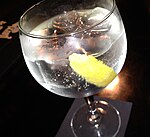
A cocktail is an alcoholic mixed drink. Most commonly, cocktails are either a single spirit or a combination of spirits mixed with other ingredients, such as juices, flavored syrups, tonic water, shrubs, and bitters. Cocktails vary widely across regions of the world, and many websites publish both original recipes and their own interpretations of older and more famous cocktails.

A Manhattan is a cocktail made with whiskey, sweet vermouth, and bitters. While rye is the traditional whiskey of choice, other commonly used whiskies include Canadian whisky, bourbon, blended whiskey, and Tennessee whiskey. The cocktail is usually stirred with ice then strained into a chilled cocktail glass and garnished traditionally with a maraschino cherry. A Manhattan may also be served on the rocks in a lowball glass.
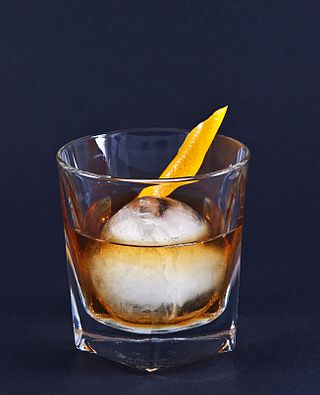
The old fashioned is a cocktail made by muddling sugar with bitters and water, adding whiskey, and garnishing with an orange slice or zest and a cocktail cherry. It is traditionally served with ice in an old fashioned glass.

The Rob Roy is a cocktail consisting primarily of whisky and vermouth, created in 1894 by a bartender at the Waldorf Astoria in Manhattan, New York City. The drink was named in honor of the premiere of Rob Roy, an operetta by composer Reginald De Koven and lyricist Harry B. Smith loosely based upon Scottish folk hero Rob Roy MacGregor.

Vermouth is an aromatized fortified wine, flavoured with various botanicals and sometimes colored. The modern versions of the beverage were first produced in the mid to late 18th century in Turin, Italy. While vermouth was traditionally used for medicinal purposes, it was later served as an apéritif, with fashionable cafés in Turin serving it to guests around the clock. In the late 19th century, it became popular with bartenders as a key ingredient for cocktails, such as the martini, the Manhattan, the Rob Roy, and the Negroni. In addition to being consumed as an aperitif or cocktail ingredient, vermouth is sometimes used as an alternative to white wine in cooking.

The Sazerac is a local variation of a cognac or whiskey cocktail originally from New Orleans, named for the Sazerac de Forge et Fils brand of cognac brandy that served as its original main ingredient. The drink is most traditionally a combination of cognac or rye whiskey, absinthe, Peychaud's Bitters, and sugar, although bourbon whiskey is sometimes substituted for the rye and Herbsaint is sometimes substituted for the absinthe. Some claim it is the oldest known American cocktail, with origins in antebellum New Orleans, although drink historian David Wondrich is among those who dispute this, and American instances of published usage of the word cocktail to describe a mixture of spirits, bitters, and sugar can be traced to the dawn of the 19th century.

A bitters is traditionally an alcoholic preparation flavored with botanical matter for a bitter or bittersweet flavor. Originally, numerous longstanding brands of bitters were developed as patent medicines, but now are sold as digestifs, sometimes with herbal properties, and as cocktail flavorings.

The martini is a cocktail made with gin and vermouth, and garnished with an olive or a lemon twist. Over the years, the martini has become one of the best-known mixed alcoholic beverages. A popular variation, the vodka martini, uses vodka instead of gin for the cocktail's base spirit.
Pink gin was historically used to reference a type of cocktail made fashionable in England in the mid-19th century, consisting of Plymouth gin and a dash of Angostura bitters, a dark red bitters that makes the whole drink pinkish. In recent years, the term Pink gin has also been used to define a specific category of gin where a range of fruits and flavourings are infused into the gin to give it a pink color.
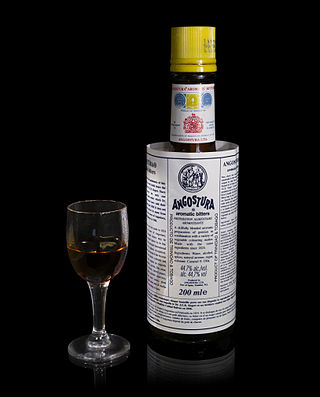
Angostura bitters is a concentrated bitters based on gentian, herbs, and spices, produced by House of Angostura in Trinidad and Tobago. It is typically used for flavouring beverages, or less often, food. The bitters were first produced in the town of Angostura, hence the name, but do not contain angostura bark. The bottle is recognisable by its distinctive oversized label. Angostura is Spanish for "narrowing", the town of Angostura having been at the first narrowing of the Orinoco River.
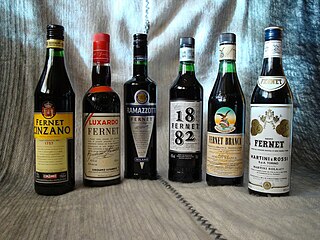
Fernet is an Italian type of amaro, a bitter, aromatic spirit. Fernet is made from a number of herbs and spices which vary according to the brand, but usually include myrrh, rhubarb, chamomile, cardamom, aloe, and especially saffron, with a base of distilled grape spirits.

The Fine Art of Mixing Drinks is a book about cocktails by David A. Embury, first published in 1948. The book is noteworthy for its witty, highly opinionated and conversational tone, as well as its categorization of cocktails into two main types: aromatic and sour; its categorization of ingredients into three categories: the base, modifying agents, and special flavorings and coloring agents; and its 1:2:8 ratio for sour type cocktails.

Orange bitters is a form of bitters, a cocktail flavoring made from such ingredients as the peels of Seville oranges, cardamom, caraway seed, coriander, anise, and burnt sugar in an alcohol base. Orange bitters, which are not to be confused with the standard Angostura aromatic bitters, are currently enjoying a resurgence among cocktail enthusiasts. It is to be noted that the well-known House of Angostura is one of the producers of orange bitters.
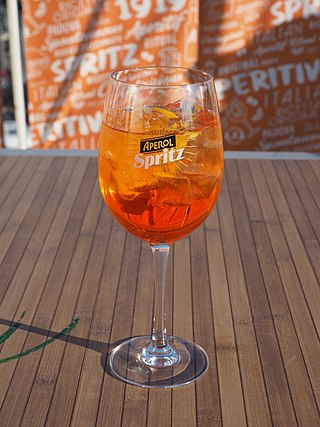
A spritz is an Italian wine-based cocktail, commonly served as an aperitif in Northeast Italy. It consists of prosecco, digestive bitters and soda water. The original Spritz Veneziano uses Select as bitters and was created in Venice in 1920. Popular variants are spritz al Campari which uses Campari and Aperol spritz which uses Aperol as bitters.
The Zazarack cocktail, later spelled Zazarac, is an American cocktail which may be related to the Sazerac, although it might have originated completely independent of the more famous drink.
Boker's Bitters was a brand of bitters manufactured by the L. J. Funke Company of New York City. The ingredient is specified in nearly every cocktail that called for bitters in Jerry Thomas' 1862 book, How to Mix Drinks or The Bon Vivant's Companion. Among the ingredients were quassia, cardamom, and bitter orange peel.

The Martinez is a classic cocktail that is widely regarded as the direct precursor to the Martini. It serves as the basis for many modern cocktails, and several different versions of the original exist. These are generally distinguished by the accompaniment of either Maraschino or Curacao, as well as differences in gin or bitters.

A whiskey cocktail is a cocktail that includes whiskey. Although whiskey is often served neat or on the rocks, it is used in many classic cocktails such as the Old Fashioned, Manhattan, and Julep. Some specifically call for Scotch whisky or bourbon whiskey.
Maurice Hegeman was an American musical theatre actor, playwright, librettist, and the inventor of the Brooklyn cocktail. He wrote the book and lyrics for the road musical Gay New York (1905), and starred in several Broadway productions produced by Florenz Ziegfeld Jr.















